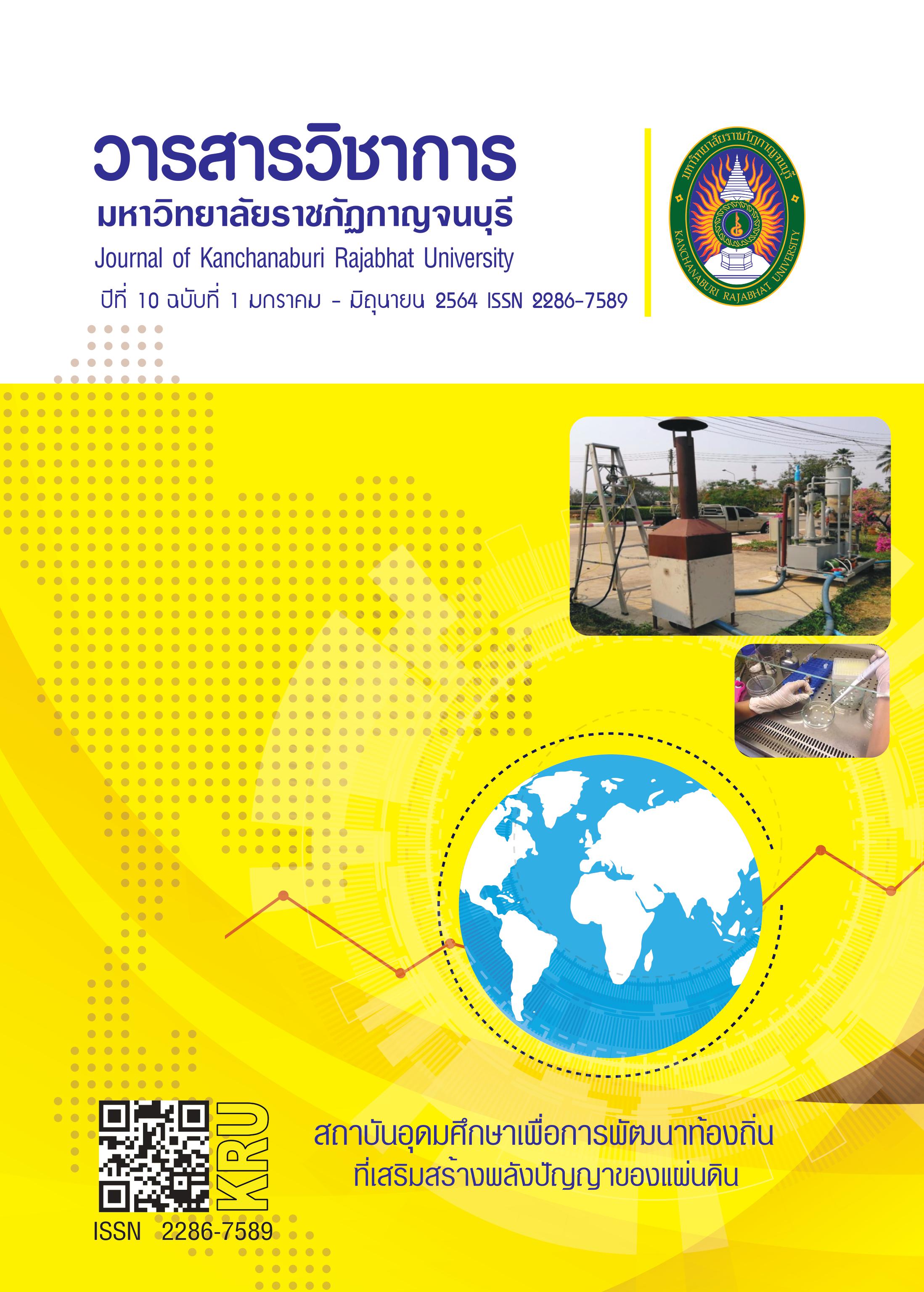MANAGEMENT OF RESIDUE CASHEW NUT SHELL USING GASIFICATION TECHNOLOGY : A CASE STUDY OF THA PLA DISTRICT, UTTARADIT PROVINCE
Main Article Content
Abstract
The amount of residue from cashew nuts processing process which is eliminated by burning impacts health and the environment. For this reason, the research on management of residue cashew nut shell using gasification technology is conducted. The objective of this is to study the chemical elements of residue cashew nuts shell as fuel by using the survey regarding the types and quantity of cashew nuts shell in Tha Pla District, Uttaradit Province, to do the proximate analysis and ultimate analysis and study the environmental impacts (chemical indicators of air pollution) between residue cashew nut shell direct-burning which is emitted from stack and gasification technology burning by measuring the amount of Carbon Dioxide, Oxygen, Carbon Monoxide, Moisture Content, Total Suspended Particulate, Sulfur Dioxide and Oxide of Nitrogen.
The result has revealed that the chemical properties of residue cashew nut shell fuel “Sisaket 60-1” (Sor Kor 60-1) and “Sisaket 60-2” (Sor Kor 60-2) ecotypes have 9.09% of Moisture Content, 2.39% of Ash, 88.28% of Volatile Matter, 0.24% of Fixed Carbon, 54.09% of Carbon (C), 6.008% of Hydrogen (H), 38.45% of Oxygen (O), 1.38% of Nitrogen (N), and Heating value at 5,071.10 Kcal/Kg. The result of measurement on the air pollution emitted from the stack caused by direct-burning of residue cashew nut shell has revealed that the content of Sulfur Dioxide (SO2) is 1.0 ppm; the Oxide of Nitrogen (NOx) is 103.9 ppm which meets the standard criteria. However, the content of Total Suspended Particulate (TSP) is 648.329 mg/m3 and that of Carbon Monoxide (CO) is 844.0 ppm, which are over the standard criteria. When we used cashew nut shell as fuel in a downdraft gasifier equipped with a gas cleaning producer system, the research results have found that the Total Suspended Particulate (TSP) is 2.532 mg/m3, the content of Sulfur Dioxide (SO2) is 1.0 ppm, the Oxide of Nitrogen (NOx) is 8.1 ppm, and Carbon Monoxide (CO) is 65.0 ppm. These meet the standard criteria in all parameters. Consequently, it is concluded that the residue cashew nut shell can be used as fuel in a downdraft gasifier equipped with a gas cleaning producer system in order to eliminate the air pollution as a result of burning. The amount of the cashew nut shell residue from the cashew nut processing process in Tha Pla District is 4,900 tons per year. This can be used as biomass fuel in the downdraft gasifier stove system in order to re-use this heat energy for cashew nut processing process.
Article Details
References
กรมพัฒนาพลังงานทดแทนและอนุรักษ์พลังงาน กระทรวงพลังงาน. (2556). ฐานข้อมูลศักยภาพชีวมวล
ในประเทศไทยประจำปีเพาะปลูก พ.ศ. 2556. ค้นเมื่อ มีนาคม 1, 2560, จาก http://webkc.dede.go.th/
testmax/node/2450.
กองเกษตรเคมี กรมวิชาการเกษตร. (2534). มะม่วงหิมพานต์. เอกสารวิชาการที่ 14. กระทรวงเกษตรและ
สหกรณ์. กรุงเทพฯ : สหกรณ์การเกษตรแห่งประเทศไทย
นคร ทิพยาวงศ์. (2553). เทคโนโลยีการแปลงสภาพชีวมวล. (พิมพ์ครั้งที่ 1). กรุงเทพมหานคร: สมาคมส่งเสริม
เทคโนโลยี (ไทย-ญี่ปุ่น).
รวิชญ์ ทวีทรัพย์. (2560). เชื้อเพลิงชีวมวล. สืบค้นเมื่อ พฤษภาคม 8, 2563, จาก https://www.thairath.co.th/content
/847708
วันทา ผ่านคำ. (2562, 1 กุมภาพันธ์). [สัมภาษณ์โดย พิทักษ์ คล้ายชม, ผู้วิจัย]. การจัดการเปลือกเมล็ดมะม่วง
หิมพานต์ ของกลุ่มส่งเสริมอาชีพบ้านหาดไก่ต้อยตำบลหาดล้า อำเภอท่าปลา จังหวัดอุตรดิตถ์.
ตำบลหาดล้า อำเภอท่าปลา จังหวัดอุตรดิตถ์.
ศุภวัฒน์ ธาดาจารุมงคล. (2559). แนวปฎิบัติที่ดีในการจัดการบำบัดและการระบายมลพิษอากาศ. ค้นเมื่อ
พฤษภาคม 8, 2563, จาก http://www.hsm.chula.ac.th/download/air/แนวปฏิบัติที่ดีในการบำบัด
และการระบายมลพิษอากาศ.pdf
ศูนย์วิจัยและพัฒนาพลังงานนครพิงค์ มหาวิทยาลัยเชียงใหม่. (2563). ใบรายงานผลการทดสอบองค์ประกอบก๊าซ
เชื้อเพลิงกากเปลือกมะม่วงหิมพานต์. เชียงใหม่ : มหาวิทยาลัยเชียงใหม่.
สำนักงานเกษตรอำเภอท่าปลา จังหวัดอุตรดิตถ์. (2560). ข้อมูลการปลูกพืชเศรษฐกิจจังหวัดอุตรดิตถ์ ปี 2558/59.
ค้นเมื่อ กันยายน 1, 2560 จาก http://www.uttaradit.doae.go.th/home/files/data57-
/october/58-59.pdf
สำนักจัดการกากของเสียและสารอันตราย กรมควบคุมมลพิษ กระทรวงทรัพยากรธรรมชาติและสิ่งแวดล้อม. (2559).
สารไดออกซินและฟิวแรน คืออะไร. ค้นเมื่อ ตุลาคม 4, 2559, จาก http://www.pcd.go.th/info_serv/haz_dioxin.html.
Daniela Thran, Martin Dotzauer, Volker Lenz, Jan Liebetrau and Andreas Ortwein. (2015). Flexible
bioenergy supply for balancing fluctuating renewables in the heat and power sector- a
review of technologies and concepts. Energy, Sustainability and Society. 2020, May 5,
Available: https://link.springer.com/content/pdf/10.1186/s13705-015-0062-8.pdf.
Miguel M. Uamusse, Kenneth M. Persson, Alberto J. Tsamba. (2014). Gasification of Cashew Nut
Shell Using Gasifier Stove in Mozambique. Journal of Power and Energy Engineering,
, 2, 11-18 Published Online July 2014 in SciRes.
Niedzitka,l., Szpryngiel, M., Kachel-Jakubowska, M., Kraszkiewicz, A., Zawislak, K., Sobczak,p.,&
Nadulski, R. (2015). Assessment of the energetic and mechanical properties of
pelletsproduced from agicultural biomass. Renewable Energy, 76, 312-317.
Ohler, J. G. (1979). Cashew. Amsterdam: Department of Agricultural Research, Koninklijk Instituut
voor de Tropen.
Tumuluru, J.S., Wright, C.T., Kenney, K.L., Hess, J.R., (2010). A Review on Biomass Densification
Technologies for Energy Applications. The INL is a U.S. Department of Energy National
Laboratory operated by Battelle Energy Alliance, Idaho National Laboratory.


